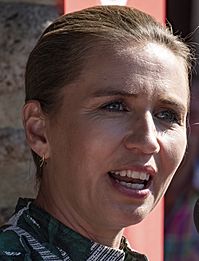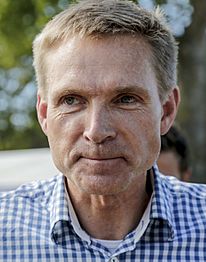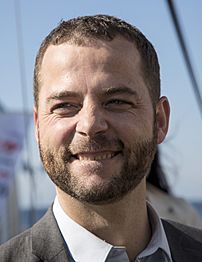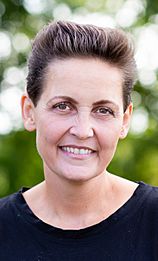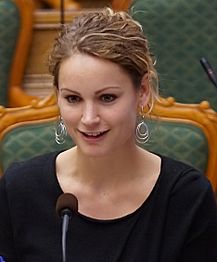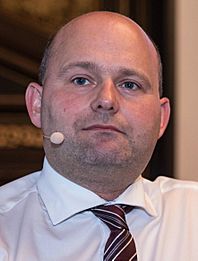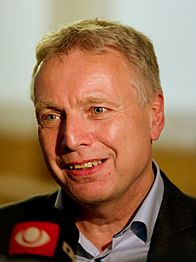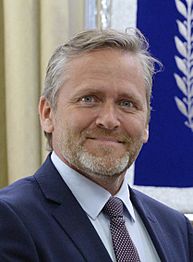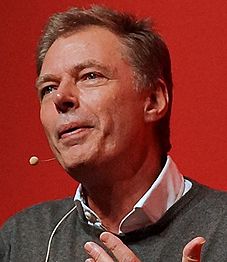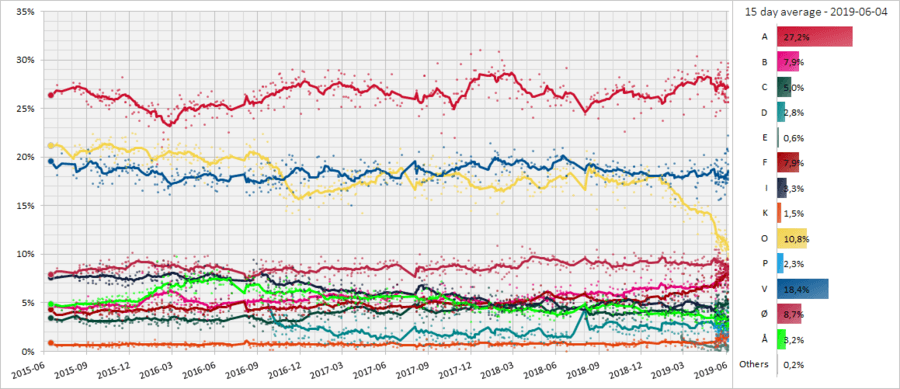2019 Danish general election facts for kids
In Denmark, a country in Europe, people vote in something called general elections to choose who will represent them in their parliament, called the Folketing. On June 5, 2019, Denmark held one of these important elections. People voted for 179 members to join the Folketing. Most of these members (175) came from Denmark itself, while two came from the Faroe Islands and two from Greenland. These elections happened just ten days after the elections for the European Parliament.
Meet the Party Leaders
This election featured many important leaders from different political parties. Here are some of them:
-
Opposition Leader
Mette Frederiksen
(Social Democrats)
from North Jutland -
Prime Minister
Lars Løkke Rasmussen
(Venstre)
from Southern Denmark -
Member of Parliament (MP)
Kristian Thulesen Dahl
(People's Party)
from Central Denmark -
Former Deputy Prime Minister
Morten Østergaard
(Social Liberal Party)
from Central Denmark -
Member of Parliament (MP)
Pia Olsen Dyhr
(Socialist People's Party)
from Capital Region -
Member of Parliament (MP)
Pernille Skipper
(Red–Green Alliance)
from North Jutland Region -
Justice Minister
Søren Pape Poulsen
(Conservative People's Party)
from Central Denmark -
Member of Parliament (MP)
Uffe Elbæk
(The Alternative)
from Central Denmark -
Architect
Pernille Vermund
(Conservative People's Party)
from Capital Region -
Foreign Minister
Anders Samuelsen
(Liberal Alliance)
from Central Denmark -
Civil servant
Isabella Arendt
(Christian Democrats)
from Southern Denmark -
Businessman
Klaus Riskær Pedersen
(Klaus Riskær Pedersen Party)
from Capital Region
What People Thought Before the Election
Before the election, surveys were done to guess how people might vote. This is called "opinion polling." The image below shows how popular different political parties were in the months leading up to the election. You can see how their support changed over time.
Election Results
The election results showed which parties won the most votes and seats in the Folketing. The Social Democrats became the largest party, winning 48 seats. The Venstre party came in second with 43 seats.
Here's a quick look at how the main parties did in terms of the percentage of votes they received:
| Popular vote in Denmark | ||||
|---|---|---|---|---|
| A | 25.9% | |||
| V | 23.4% | |||
| O | 8.7% | |||
| B | 8.6% | |||
| F | 7.7% | |||
| Ø | 6.9% | |||
| C | 6.6% | |||
| Å | 3.0% | |||
| D | 2.4% | |||
| I | 2.3% | |||
| P | 1.8% | |||
| K | 1.7% | |||
| E | 0.8% | |||
| Others | 0.1% | |||
The total number of votes counted in Denmark was about 3.5 million, with a high turnout of 84.6% of registered voters. This means a lot of people participated in choosing their government.
The Faroe Islands and Greenland also elected their representatives. In the Faroe Islands, the Union Party and the Social Democratic Party each won one seat. In Greenland, Inuit Ataqatigiit and Siumut each won one seat.
See also
 In Spanish: Elecciones generales de Dinamarca de 2019 para niños
In Spanish: Elecciones generales de Dinamarca de 2019 para niños


